
Before my daughter could say Hot Cross Buns, she would call them Hossbuns. For me, the nickname of these spiced and very slightly sweet buns has stuck.
The first time I tried to make them a few years ago I struggled to incorporate all of the dried fruit in to what was quite a stiff dough. Last year I started to experiment with my own recipe, and this year, I have finally settled on one, influenced slightly by the Scandinavian flavours found in the Swedish Semlor that I made recently.
The process may seem rather long and laborious, especially when there are Hot Cross Bun recipes out there that only involve one prove before shaping, and one after, before firing them into the oven. However, I have been trying to understand the chemical process of bread making a little bit more, reading my trusty Hamelman, and bending the ears of those who know far more than I do. Sometimes it pays to do take your time.
I have been using Gilchesters Unbleached Flour again. This flour has a lower protein content, therefore it struggles to develop gluten in the way that some other bread flours do. Without well developed gluten strands the bread’s structure will be weak. In order to overcome this, I tried giving the dough a much longer time to bulk, but folded it during the process. Folding can be done in a couple of ways (based on my own limited knowledge). If you have a very soft and suppled dough, you simply slip your hands underneath it whilst it is in the bowl, lift and tuck under. Rotate the bowl and do the same again. It is probably best to look up a video for this manoeuvre as I don’t think my description is going to do it justice.
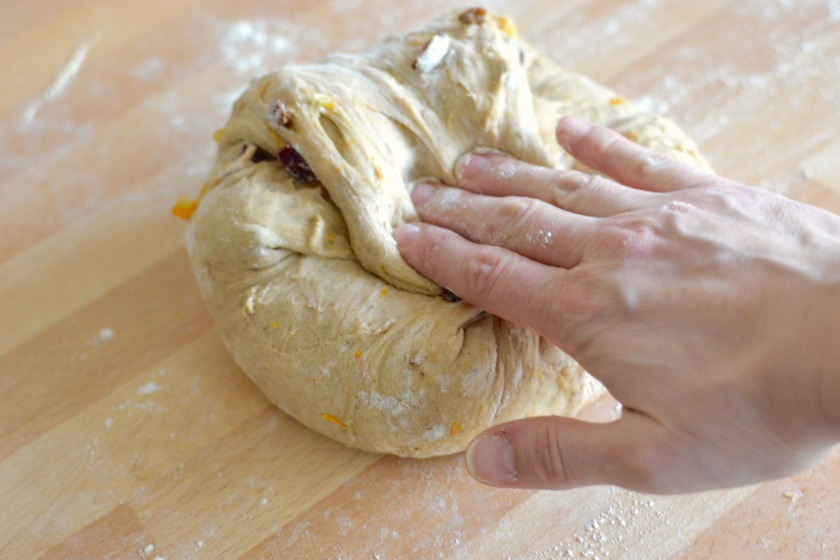
Folding the dough into the centre.
The other way, which works well with this dough, is to simply turn it out on the board, top of the dough now facing the worktop, de-gas the dough (bash it flat with the palms of your hands), then take sections of the dough form the edges and fold them into the centre, working all the way round until you have a compact ball shape again. When placing it back in the bowl to bulk again, remember to out the seam bottom down and the top facing up again.
Anyway, let’s get on with the recipe.
Cranberry and Orange Hot Cross Buns
500g Bread Flour
250g Milk
2 Large Eggs
15g Instant Dried Yeast
10g Salt
40g Caster Sugar
60g Butter, at room temperature
1/2 Teaspoon of Ground Nutmeg
1 Teaspoon of Ground Cinnamon
2 Teaspoons of Mixed Spice
1/2 Teaspoon of Ground Cardamom Seeds
40g Dried Cranberries
40g Sultanas
30g Whole Candied Orange Peel
The zest of two Oranges
The juice of one Orange
25g of sugar and the juice of the second orange for the glaze
30g of flour to make a paste for the crosses.
Start at least an hour before you want start making the dough by mixing the dried cranberries, sultanas, chopped candied orange peel and orange zest with the juice of one orange.
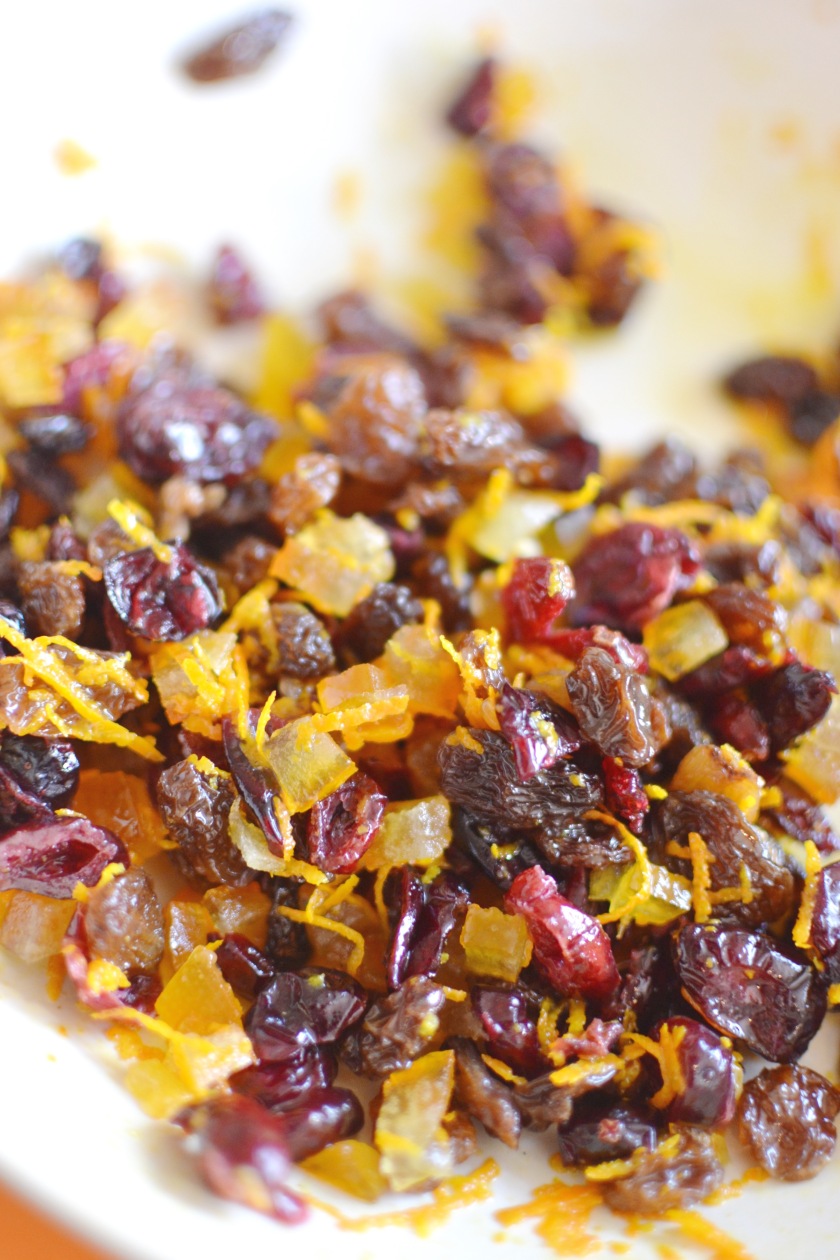
Allow the dried fruit to plump up in the orange juice and absorb its flavour.
Put all the other ingredients into the mixing bowl of your food mixer, if using, and, with your dough hook, mix all of the ingredients together on the slowest speed for a minute or two until they are incorporated.
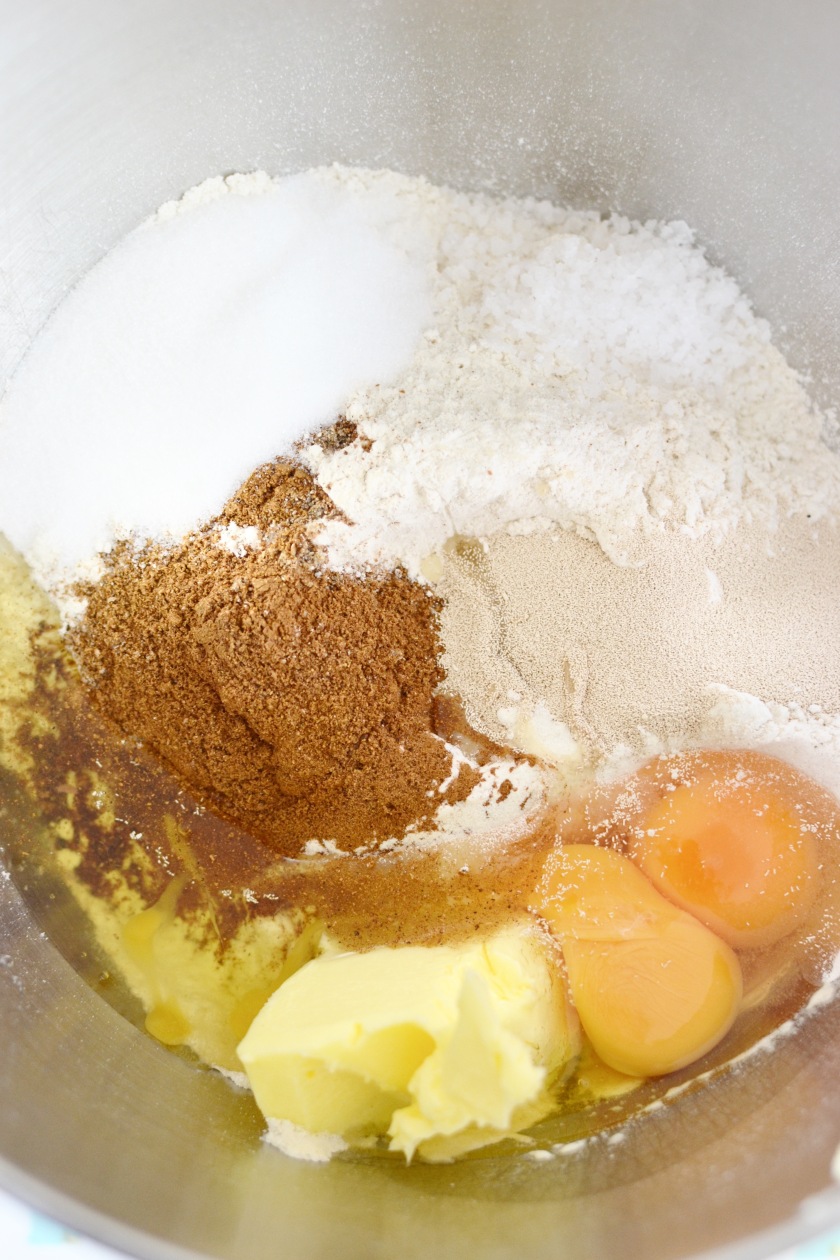
Then increase the speed to medium and mix the dough for about five or six minutes. It will be firm and a little bit sticky. Scrape it on to the worktop that has been sprinkled with a scant amount of flour and finish the dough off my hand but scraping it into a tight ball with a dough scraper and lifting and slapping over a handful of times, before scraping into a high ball again. Place the dough into the bowl, cover with a clean cloth and leave to bulk for half an hour.

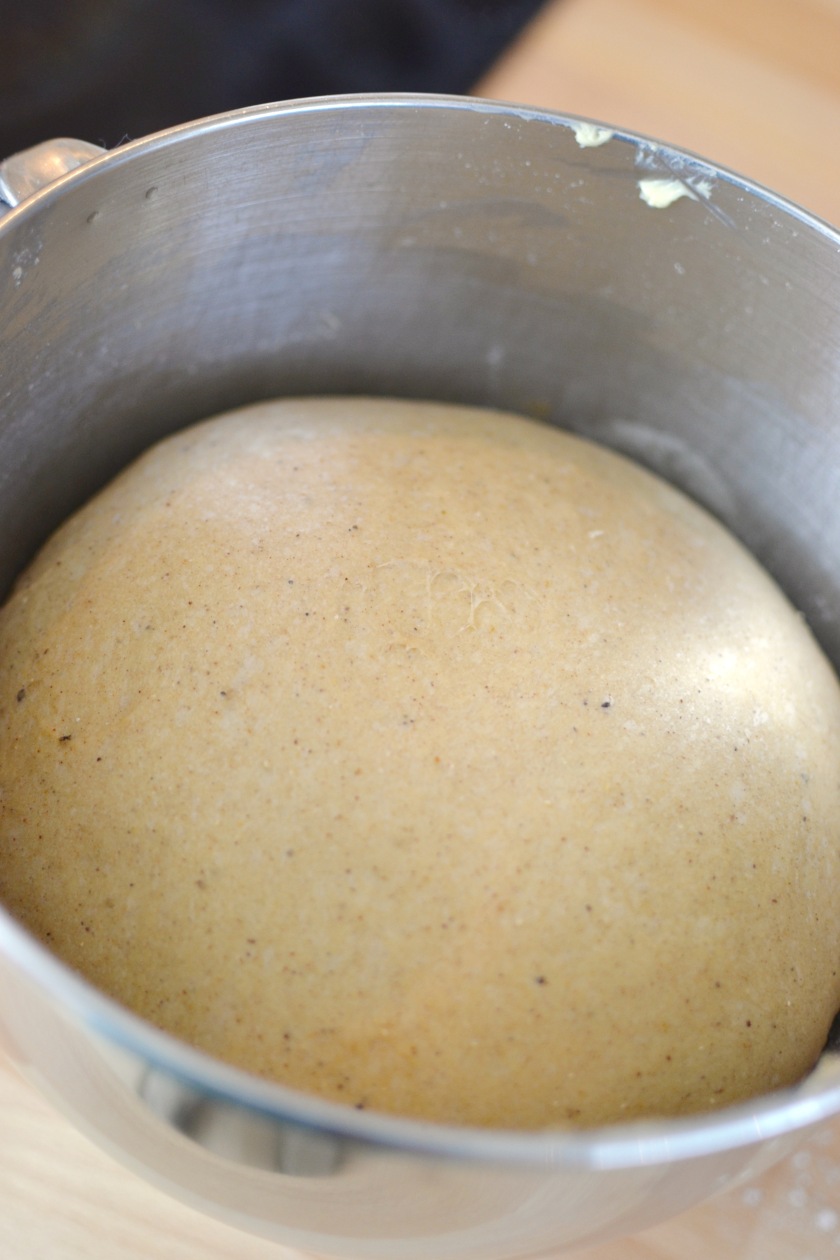
Even after half an hour the dough will have bulked a little and feel less tight.
After half an hour, turn the dough out onto the worktop again, flattening it with the palms of your hand. Spread over the dried fruits and orange zest, leaving behind any orange juice that hasn’t been absorbed.

Spread out the fruits and gently press in to the dough with your fingers.
Tightly roll up the dough towards yourself then start to work the fruit in to the dough by kneading. It *will* get messy and sticky, but don’t panic. Keep going until the fruit it evenly distributed through the dough and use the dough scraper to bring it back into a tight ball again.

Place in the lightly floured bowl again, cover with a cloth and leave to prove for an hour.
After an hour, scrape the dough onto the worktop again (top facing down), gently de-gas and fold the dough.

Folding the dough in on itself creates strength and improves the texture of the buns.
Place it back in the bowl, as before, for another hour. Another reason for the extra proving time with these buns is that the spices slow down the dough development, so it needs a little longer to do its thing. But it is worth it, as the dough is better flavoured and stronger, therefore easier to work with and shape.
Once the dough has had this extra hour it is time to turn it out for the last time and to shape the buns. Divide the dough evenly in to twelve pieces. As when folding the dough, fold the buns into themselves befoe shaping with your hand into tight little balls, not scraggy lumps of dough! Space them evenly on a baking sheet.
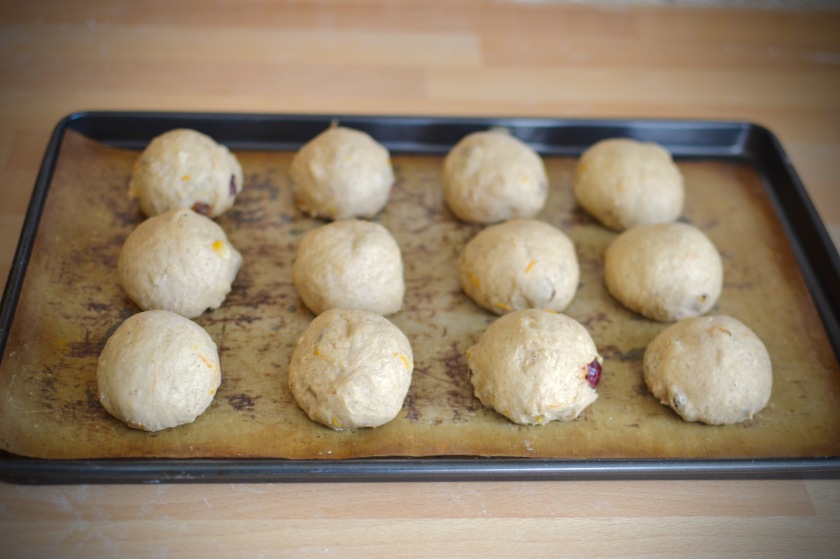
Cover the buns with a cloth to prevent a skin forming and leave them to prove one last time for an hour to an hour and a half.
About half an hour before you bake them, turn the oven on to 220C or 200C fan and make up the flour and water paste for the crosses with 30g of flour. The paste should be easy to pipe out but not running out of the piping bag.
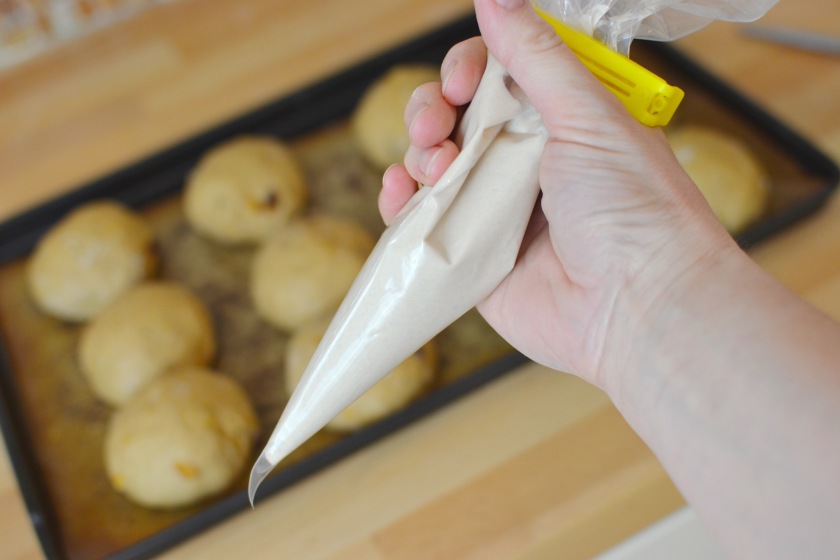
I use a disposable bag and snip the end off when I am ready to pipe.
When it is almost time to bake them, pipe crosses over the buns prior to putting them in the oven.
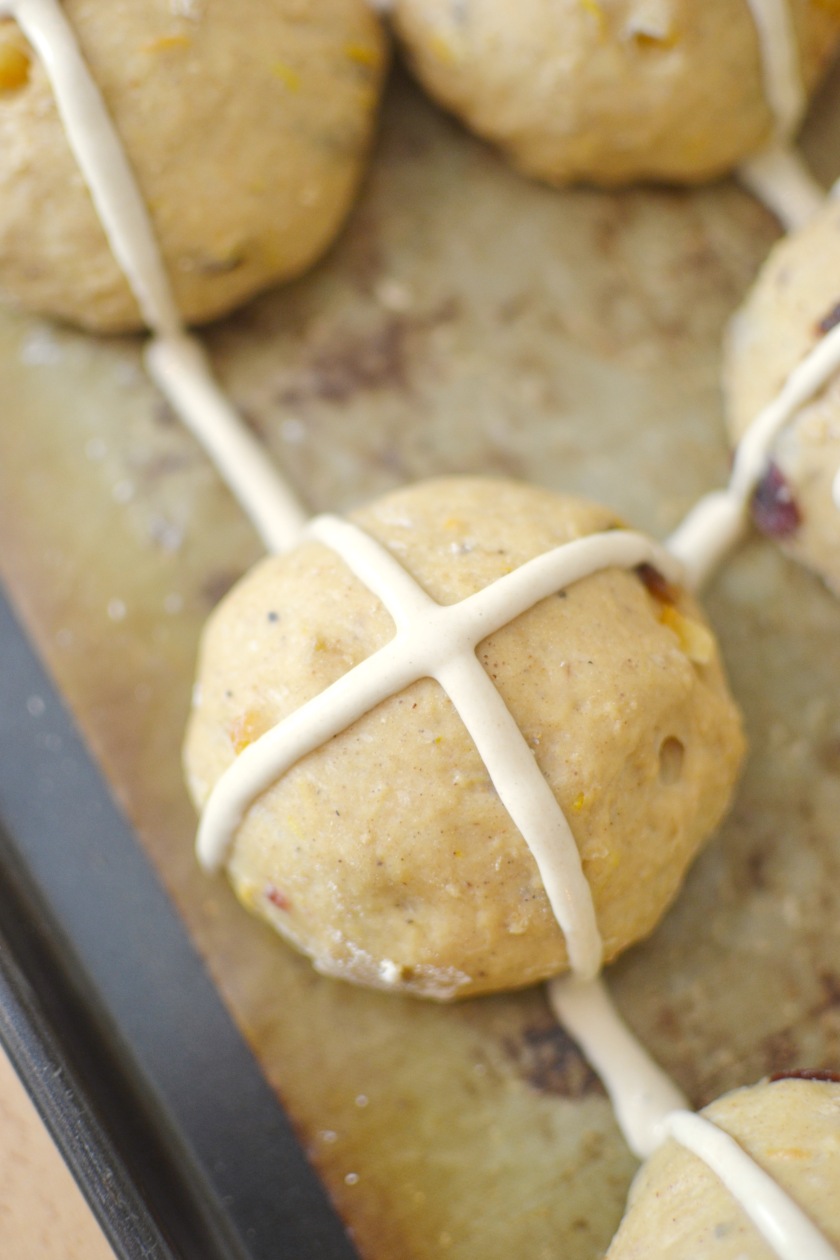
Bake them for 12-15 minutes until they are golden on top, risen and sound hollow when tapped.
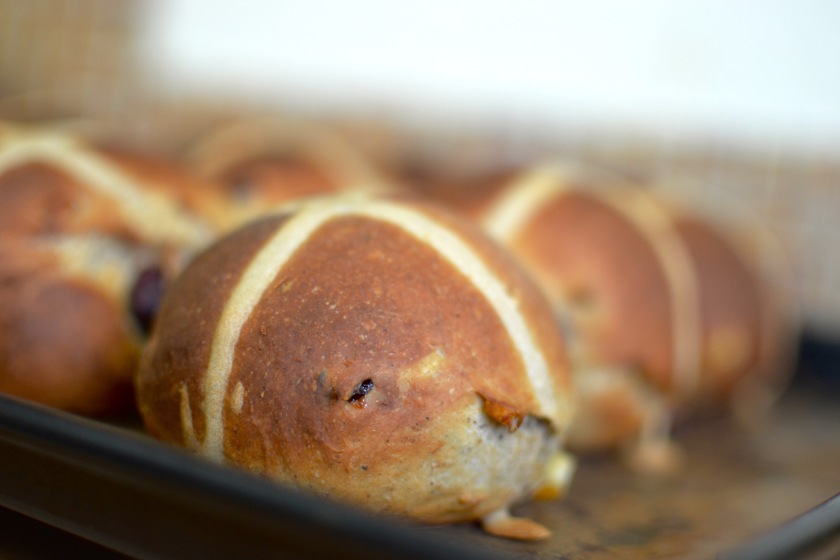
When you take them out of the oven, paint them with a glaze made from bringing to the boil 25g of sugar and 4 teaspoons of orange juice.

I like to allow mine to cool then eat them with butter or toast and lather in butter.

However you like to eat your Hot Cross Buns, I hope you enjoy trying out my recipe.


So what’s the benefit of using a low protine flour like this instead of normal bread flour? Can I use a supermarket bread flour? I have no Ida how much protine it has, usually I use the Alisons one. I’ll definitely be trying these, hopefully more luck than I had with my Selmor. Fab that you are writting your own recipes, you are so clever. X
LikeLiked by 1 person
There is no benefit as such but I came across Gilchesters Unbleached flour and like the idea of using a flour that had been less treated by chemicals. It has a lower protein because it grown in a cooler climate (I think). You can use regular bread flour for this recipe, though I’d recommend an organic one.
LikeLike
But there’s always an advantage to taking longer to develop your dough: more flavour!
LikeLike
These hoss buns look absolutely gorgeous. I am going to use this method, although the orange will be replace with apple juice and lemon rind, as I’m allergic to oranges. It’s lovely to see plump, round, golden buns, instead of the flattered packet ones in the super market. Thank you for sharing your technique, I’ll let you know how I get on. Sammie.
LikeLiked by 1 person
Oh great stuff, thank you. The lemon will work well with the cardamon in the dough. 😊
LikeLike
You’ve convinced me to add another prove into my own recipe Frances and why, oh why did I not think to use orange use and sugar to glaze with instead of sugar and water??? I adore HXBs 😀
LikeLiked by 1 person
I know! The juice is already sitting there and adds another layer of flavour. It came to me when I was in my second trial batch.
LikeLiked by 1 person
A stroke of genius 😀
LikeLiked by 1 person
Ooh I can almost smell these! They look wonderful 🙂 x
LikeLiked by 1 person
Thank you 😊
LikeLike
These buns are an absolute favourite in our house. They are totally delicious and we have never had shop bought since. They are wonderful made into a pimped ‘bread & butter’ pudding too!
LikeLike